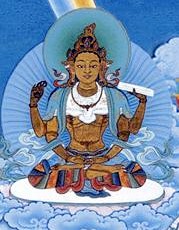Vajra Cutter Sutra: Difference between revisions
No edit summary |
No edit summary |
||
| Line 1: | Line 1: | ||
[[Image:Prajnaparamita.jpg|frame|The goddess Prajñaparamita]] | [[Image:Prajnaparamita.jpg|frame|The goddess Prajñaparamita]] | ||
The '''''Vajra Cutter Sutra''''' ( | The '''''Vajra Cutter Sutra''''' (or '''''Diamond Sutra''''') (Skt. ''Vajracchedikā-prajñāpāramitā-sūtra''; Tib. འཕགས་པ་ཤེས་རབ་ཀྱི་ཕ་རོ་ཏུ་ཕྱིན་པ་རྡོ་རྗེ་གཅོད་པ་ཞེས་བྱ་བ་ཐེག་པ་ཆེན་པོའི་མདོ, ''pakpa sherab kyi parol tu chinpa dorje chöpa shyé jawa tekpa chenpö do'', [[Wyl.]] ''’phags pa shes rab kyi pha rol tu phyin pa rdo rje gcod pa zhes bya ba theg pa chen po’i mdo'')<ref>Also known as ''The Sutra in Three Hundred Lines'' (Skt. ''triśātikā'')</ref> is a popular [[Prajnaparamita]] [[sutra]]. | ||
==Early Translations== | ==Early Translations== | ||
*Chinese translation, ca. AD 400 by Kumārajīva | *Chinese translation, ca. AD 400 by Kumārajīva | ||
*Chinese translation in the 7th century by Xuanzang | *Chinese translation in the 7th century by Xuanzang | ||
*Tibetan translation in the 9th century by | *Tibetan translation ([[Toh]] 16) in the 9th century by [[Shilendrabodhi]] and [[Yeshé Dé]] | ||
==Modern Translations== | ==Modern Translations== | ||
| Line 31: | Line 31: | ||
[[Category:Texts]] | [[Category:Texts]] | ||
[[Category:Sutras]] | [[Category:Sutras]] | ||
[[Category:Mahayana Sutras]] | |||
[[Category:Prajnaparamita]] | [[Category:Prajnaparamita]] | ||
Revision as of 21:44, 11 November 2020

The Vajra Cutter Sutra (or Diamond Sutra) (Skt. Vajracchedikā-prajñāpāramitā-sūtra; Tib. འཕགས་པ་ཤེས་རབ་ཀྱི་ཕ་རོ་ཏུ་ཕྱིན་པ་རྡོ་རྗེ་གཅོད་པ་ཞེས་བྱ་བ་ཐེག་པ་ཆེན་པོའི་མདོ, pakpa sherab kyi parol tu chinpa dorje chöpa shyé jawa tekpa chenpö do, Wyl. ’phags pa shes rab kyi pha rol tu phyin pa rdo rje gcod pa zhes bya ba theg pa chen po’i mdo)[1] is a popular Prajnaparamita sutra.
Early Translations
- Chinese translation, ca. AD 400 by Kumārajīva
- Chinese translation in the 7th century by Xuanzang
- Tibetan translation (Toh 16) in the 9th century by Shilendrabodhi and Yeshé Dé
Modern Translations
In English
- Gelong Thubten Tsultrim (George Churinoff), The Exalted Mahayana Sutra on the Wisdom Gone Beyond Called the Vajra Cutter (based on the Tibetan Lhasa Zhol printing), FPMT, 2002 Available online here
- Paul Harrison, 'Vajracchedikā Prajñāpāramitā: A New English Translation of the Sanskrit Text Based on Two Manuscripts from Greater Gandhāra', contained in Jens Braarvig, Paul Harrison, Jens-Uwe Hartmann, Kazunobu Matsuda & Lore Sander, eds., Buddhist Manuscripts in the Schøyen Collection, Hermes (Oslo 2006)
- Gregory Schopen, 'The Manuscript of the Vajracchedika Found at Gilgit: An Annotated Transcription and Translation' in Luis O. Gómez and Jonathan A. Silk (ed.s), Studies in the Literature of the Great Vehicle: Three Mahāyāna Buddhist Texts
In French
- Philippe Cornu and Patrick Carré, Soûtra du diamant et autres soûtras de la voie médiane, (Paris: Fayard, 2001) (translated from Tibetan and Chinese versions)
Famous Quotes
གང་དག་ང་ལ་སྒྲར་ཤེས་པ། །
ལོག་པར་སྤོང་བས་ཞུགས་པ་སྟེ། །
Those who see my body as ordinary form,
And hear my voice as ordinary sound,
Have set out upon a mistaken path.
Such people do not truly see me.
སྒྱུ་མ་ཟིལ་པ་ཆུ་བུར་དང་། །
རྨི་ལམ་གློག་དང་སྤྲིན་ལྟ་བུ། །
Like a star, hallucination, candle,
Magical illusion, dewdrop, bubble,
Dream, lightning or a cloud—
Know all compounded phenomena to be like this.
Notes
- ↑ Also known as The Sutra in Three Hundred Lines (Skt. triśātikā)
Further Reading
- Thich Nhat Hanh, The Diamond that Cuts Through Illusion: Commentaries on the Prajñaparamita Diamond Sutra (Berkeley: Parallax Press, 1992)
- Edward Conze, The Prajñāpāramitā Literature (1960)